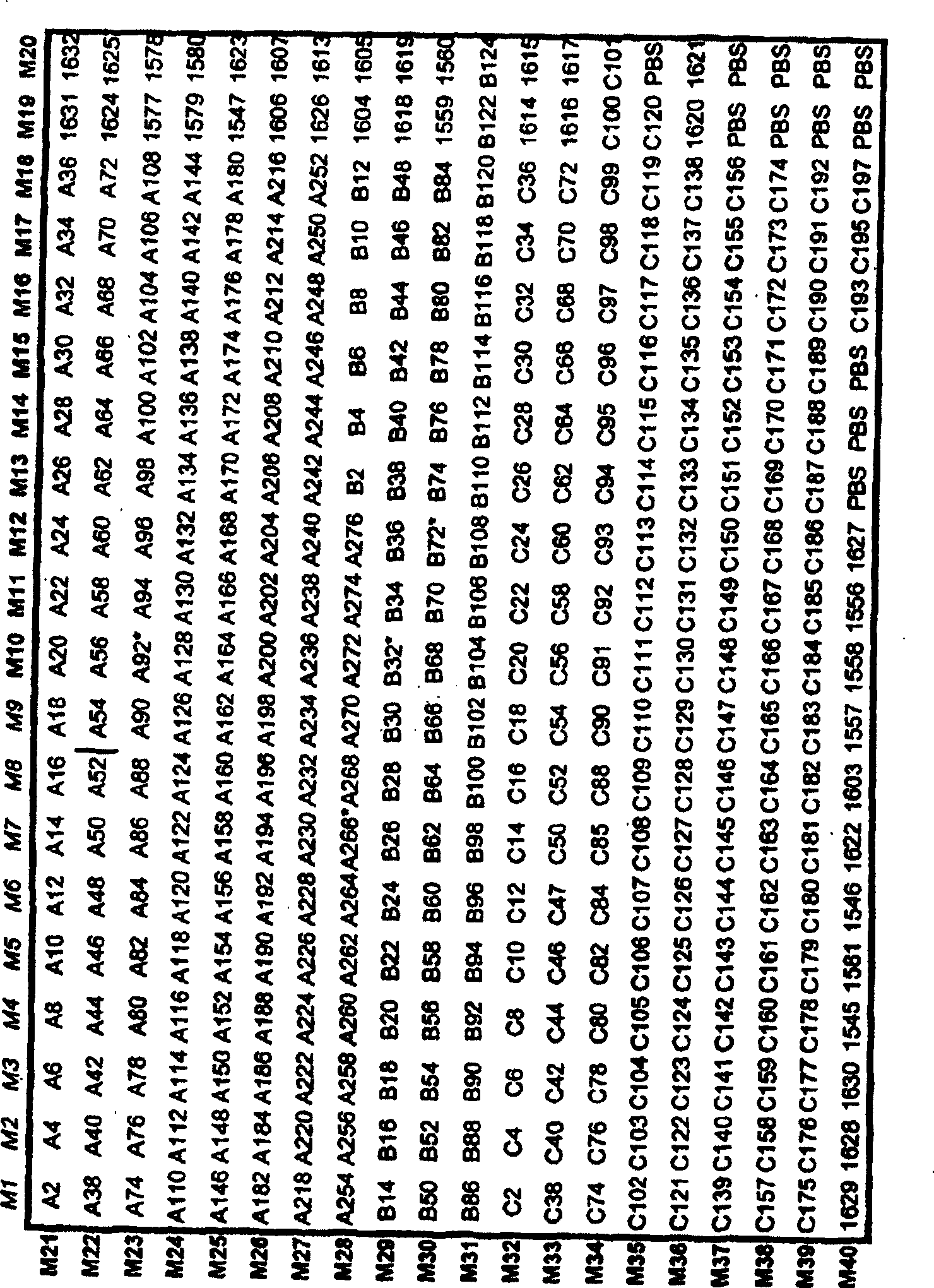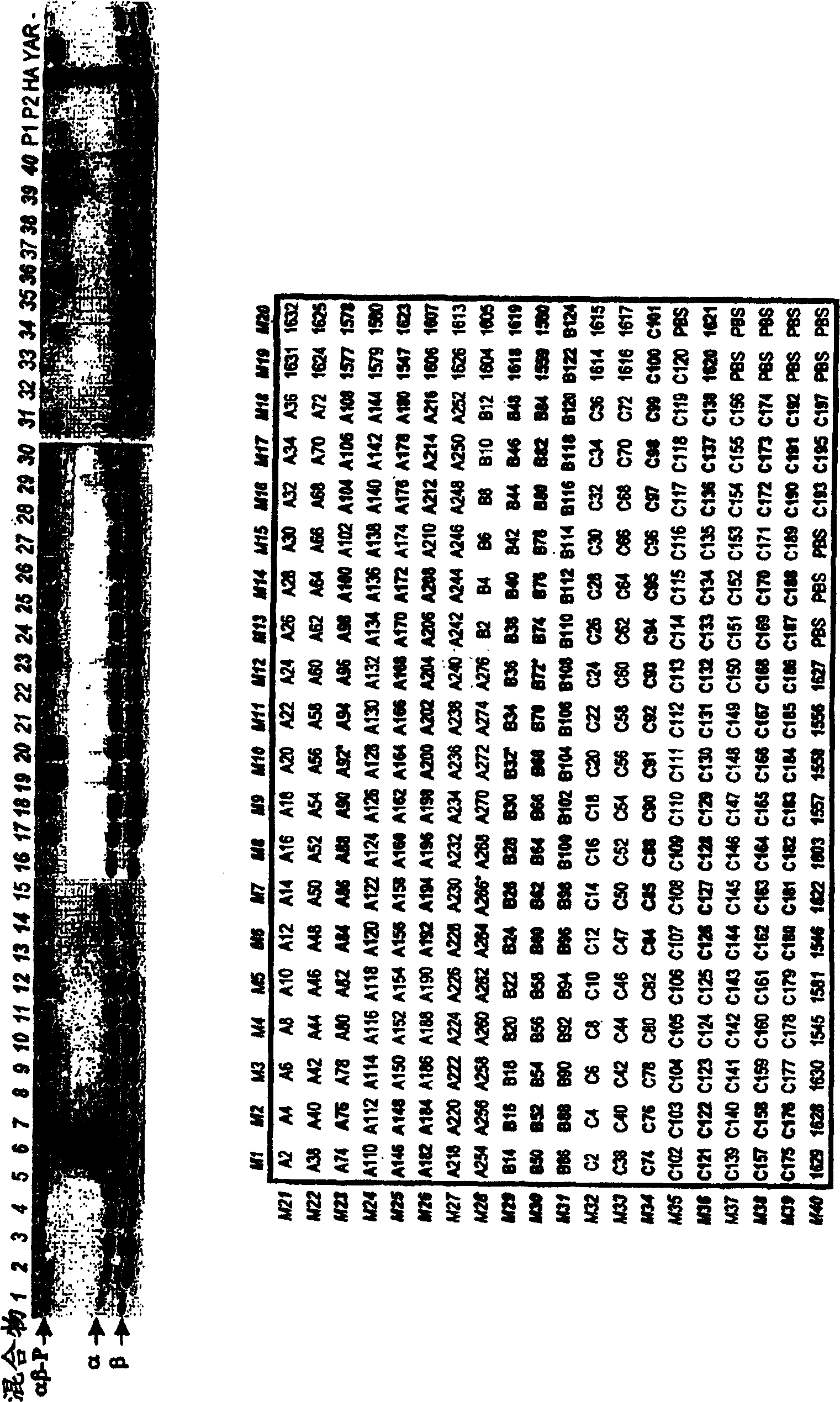Method for isolating hepatitis c virus peptides
A hepatitis C virus, molecular technology, applied in the field of HCV T cell epitopes, can solve the problem of not knowing the immune response in detail
- Summary
- Abstract
- Description
- Claims
- Application Information
AI Technical Summary
Problems solved by technology
Method used
Image
Examples
Embodiment I
[0127] Example I. Rapid identification of promiscuous HLA-binding peptides from HCV by assaying peptide libraries arranged in a matrix
[0128] To cover conserved regions within the HCV polyprotein, more than 640 peptides were synthesized (Table 1). For the rapid identification of HLA ligands and novel T cell epitopes, 40 peptide libraries were prepared, each containing 20 unique peptides. These libraries were constructed with each peptide present in 2 libraries (matrix format). This allowed the identification of reactive peptides located at the intersection of row and column mixtures (Figure 1 HCV peptide matrix).
[0129] Table 1. Synthetic peptides derived from HCV conserved regions
[0130]
[0131]
[0132]
[0133] For epitope capture, each peptide library was incubated with soluble recombinant HLA class II molecules and specific binding was assessed by SDS stability assay. Using the HLA molecule DRB1 * 0401, DRB1 * 0404 and DRB1 * The results for 0101 are...
Embodiment II
[0151] To determine the best epitope within a longer polypeptide, mice can be vaccinated with the longer polypeptide incorporating the candidate epitope sequence. Generation of specific CD4+ T cell responses against naturally processed and presented epitopes can then be assayed by restimulation of murine splenocytes or lymph node cells with overlapping 15-mers and IFN-γ ELIspot. Final confirmation of newly identified HLA-ligands can be achieved by testing these peptides with T cells from humans. Ideally, include responders to treatment or those who recover spontaneously from infection. Example II. Immunogenicity of HCV-derived peptides in HLA transgenic mice
[0152] Immunogenicity of HCV-derived synthetic peptides (from conserved regions) was studied in HLA transgenic mice: 36 out of 68 peptides examined were found to induce peptide-specific IFN-γ producing cells in vaccination experiments. As summarized in Table 3, some peptides in DR4- and / or A * 0201 transgenic mice wer...
Embodiment III
[0161] Example III. HLA restriction of HCV-derived immunogenic peptides studied in transgenic mice
[0162] Several groups of 5 mice per group (HLA-A * 0201-, HLA-DRB1 * 0401- and HLA-B * 0702 transgenic mice, male, 8-14 weeks old) were subcutaneously injected with 100 μg of peptide+IC31 per mouse (50 μg per footpad) into the hind footpad. (PCT / EP01 / 12041, WO 02 / 32451A1 and PCT / EP01 / 06433, WO 01 / 93905A1; IC31 is a combination of immunological agents disclosed in WO 01 / 93905 and WO02 / 32451).
[0163] Six days after inoculation, single-cell suspensions of pooled spleens were prepared, and pure fractions, CD8+ fractions for A2 and B7tg mice (for B7 CD8+ fraction for mice containing 97% CD8 and 1.5% CD4 cells, 83% CD8 and 8% CD4 cells for A2tg mice), CD4+ fraction for DR4tg mice (for DR4tg small Mouse is the CD4+ fraction, containing 98% CD4 cells and 0.2% CD8 cells). All cells (not isolated cells, positive and corresponding negative fractions) were restimulated ex vivo with ...
PUM
 Login to View More
Login to View More Abstract
Description
Claims
Application Information
 Login to View More
Login to View More - R&D
- Intellectual Property
- Life Sciences
- Materials
- Tech Scout
- Unparalleled Data Quality
- Higher Quality Content
- 60% Fewer Hallucinations
Browse by: Latest US Patents, China's latest patents, Technical Efficacy Thesaurus, Application Domain, Technology Topic, Popular Technical Reports.
© 2025 PatSnap. All rights reserved.Legal|Privacy policy|Modern Slavery Act Transparency Statement|Sitemap|About US| Contact US: help@patsnap.com



